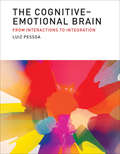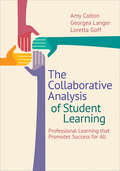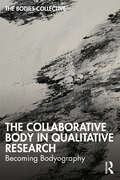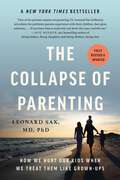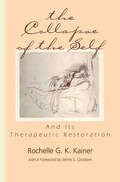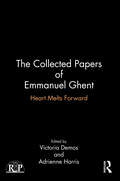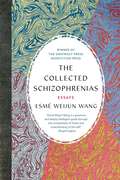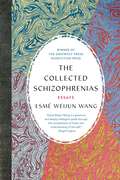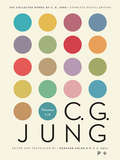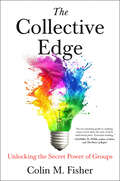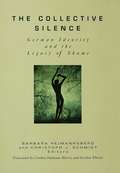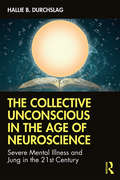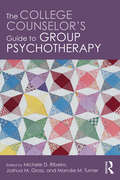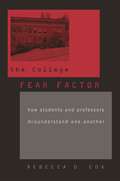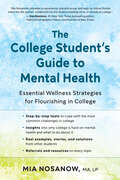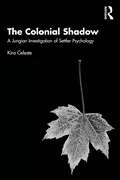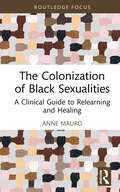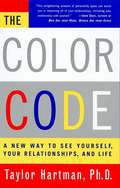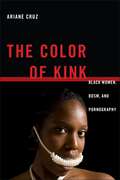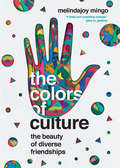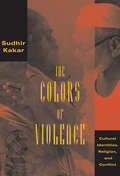- Table View
- List View
The Cognitive-Emotional Brain: From Interactions to Integration (The\mit Press Ser.)
by Luiz PessoaA study that goes beyond the debate over functional specialization to describe the ways that emotion and cognition interact and are integrated in the brain.The idea that a specific brain circuit constitutes the emotional brain (and its corollary, that cognition resides elsewhere) shaped thinking about emotion and the brain for many years. Recent behavioral, neuropsychological, neuroanatomy, and neuroimaging research, however, suggests that emotion interacts with cognition in the brain. In this book, Luiz Pessoa moves beyond the debate over functional specialization, describing the many ways that emotion and cognition interact and are integrated in the brain. The amygdala is often viewed as the quintessential emotional region of the brain, but Pessoa reviews findings revealing that many of its functions contribute to attention and decision making, critical components of cognitive functions. He counters the idea of a subcortical pathway to the amygdala for affective visual stimuli with an alternate framework, the multiple waves model. Citing research on reward and motivation, Pessoa also proposes the dual competition model, which explains emotional and motivational processing in terms of their influence on competition processes at both perceptual and executive function levels. He considers the broader issue of structure-function mappings, and examines anatomical features of several regions often associated with emotional processing, highlighting their connectivity properties. As new theoretical frameworks of distributed processing evolve, Pessoa concludes, a truly dynamic network view of the brain will emerge, in which "emotion" and "cognition" may be used as labels in the context of certain behaviors, but will not map cleanly into compartmentalized pieces of the brain.
The Collaborative Analysis of Student Learning: Professional Learning that Promotes Success for All
by Amy B. Colton Georgea M. Langer Loretta GoffA proven approach to transformative professional learning that raises achievement for all students! Does professional learning at your school promote teacher growth and propel student achievement? If you’re ready for a change, turn to trusted educators Colton, Langer, and Goff, pioneers of an extraordinarily effective design for professional learning: Collaborative Analysis of Student Learning (CASL). You’ll find complete strategies, resources and more in this evidence-based book that addresses the Common Core State Standards. Learn how to: Benefit from the lessons learned by the authors over two decades of nationwide implementation as you design a sustainable CASL program that drives positive change at your school Inquire into student work and assessments to promote learning excellence for all Use the CASL Teacher as Collaborative Inquirer framework to promote culturally competent, academically rigorous teaching Develop and implement new instructional strategies that mesh with Common Core standards Discover how to put CASL in place at your school, helping faculty – and students – to reach their full potential. "This book is extraordinary and a must have for every practitioner striving to improve student learning! Colton, Langer, and Goff provide explicit guidance on building a culture of collaborative inquiry to empower teachers and leaders to explore their own practices in a way that fosters meaningful and relevant learning for students." Victoria Duff, Coordinator of Professional Learning New Jersey Principal and Supervisors Association "Teacher collaborative professional learning leads to improved teaching and student learning when it is skillfully orchestrated. In this book, Colton, Langer, and Goff provide an essential resource rich with strategies, tactics, tools, and examples to guide both facilitators and team members to structure collaborative inquiry, analysis, and learning in ways that deepen their learning and practice and increase results for all students." Joellen Killion, Senior Advisor Learning Forward
The Collaborative Analysis of Student Learning: Professional Learning that Promotes Success for All
by Amy B. Colton Georgea M. Langer Loretta GoffA proven approach to transformative professional learning that raises achievement for all students! Does professional learning at your school promote teacher growth and propel student achievement? If you’re ready for a change, turn to trusted educators Colton, Langer, and Goff, pioneers of an extraordinarily effective design for professional learning: Collaborative Analysis of Student Learning (CASL). You’ll find complete strategies, resources and more in this evidence-based book that addresses the Common Core State Standards. Learn how to: Benefit from the lessons learned by the authors over two decades of nationwide implementation as you design a sustainable CASL program that drives positive change at your school Inquire into student work and assessments to promote learning excellence for all Use the CASL Teacher as Collaborative Inquirer framework to promote culturally competent, academically rigorous teaching Develop and implement new instructional strategies that mesh with Common Core standards Discover how to put CASL in place at your school, helping faculty – and students – to reach their full potential. "This book is extraordinary and a must have for every practitioner striving to improve student learning! Colton, Langer, and Goff provide explicit guidance on building a culture of collaborative inquiry to empower teachers and leaders to explore their own practices in a way that fosters meaningful and relevant learning for students." Victoria Duff, Coordinator of Professional Learning New Jersey Principal and Supervisors Association "Teacher collaborative professional learning leads to improved teaching and student learning when it is skillfully orchestrated. In this book, Colton, Langer, and Goff provide an essential resource rich with strategies, tactics, tools, and examples to guide both facilitators and team members to structure collaborative inquiry, analysis, and learning in ways that deepen their learning and practice and increase results for all students." Joellen Killion, Senior Advisor Learning Forward
The Collaborative Body in Qualitative Research: Becoming Bodyography
by Davina Kirkpatrick Sarah Helps Bodies Collective Ryan Bittinger Claudia Canella Jess Erb Mark Huhnen Alys MendusThe Collaborative Body in Qualitative Research challenges normative philosophies that have frequently neglected the body’s place in research and then illustrates how the body is essential for all meaning making. By ‘voicing the body’, the first part of this rebellious book problematizes how the body is used/assessed, yet often silenced in academic writing. This book then fluidly moves to celebrating the body through discussing taboo topics like sex/sexuality in friendship, underwear (knickers), ageing, and death, as well as how a non-binary body moves in a heteronormative world. Through the lens of Bodyography, this book does research differently – illuminating how the body flourishes, excites knowledge, and is complicated when placed on a ‘screen’. This book celebrates a collaborative and arts-based approach. This book is a dialogue between The Bodies Collective, with dialogic resonance sections between each chapter and art pieces throughout. This book will encourage all scholars to do research differently. Anyone with a thirst to challenge normative practices in academia and who wants research to be inspiring and playful will fall in love with this book.
The Collapse of Parenting: How We Hurt Our Kids When We Treat Them Like Grown-Ups
by Leonard SaxIn this New York Times bestseller, one of America&’s premier physicians offers a must-read account of the new challenges facing parents today and a program for how we can better prepare our children to navigate the obstacles they face In The Collapse of Parenting, internationally acclaimed author Leonard Sax argues that rising levels of obesity, depression, and anxiety among young people can be traced to parents abdicating their authority. The result is children who have no standard of right and wrong, who lack discipline, and who look to their peers and the Internet for direction. Sax shows how parents must reassert their authority - by limiting time with screens, by encouraging better habits at the dinner table, and by teaching humility and perspective - to renew their relationships with their children. Drawing on nearly thirty years of experience as a family physician and psychologist, along with hundreds of interviews with children, parents, and teachers, Sax offers a blueprint parents can use to help their children thrive in an increasingly complicated world.
The Collapse of the Self and Its Therapeutic Restoration (Relational Perspectives Book Series #15)
by Rochelle G. KainerThe Collapse of the Self and Its Therapeutic Restoration is a rich and clinically detailed account of the therapeutic restoration of the self, and speaks to the healing process for analysts themselves that follows from Rochelle Kainer's sensitive integration of heretofore dissociated realms of psychoanalytic theory. In describing how the reworking of pathological internal object relationships occurs in conjunction with the transformation of selfobject failures, Kainer brings new insight to bear on the healing of the self at the same time as she contributes to healing the historic split in psychoanalysis between Kleinian theory and self psychology. Extensive case illustrations, refracted through the lens of her uniquely integrative perspective, bring refreshing clarity to elusive theoretical concepts. Of special note is Kainer's distinction between normal and pathological identifications. Equally valuable is her introduction of the term "imaginative empathy" to characterize the kind of attunement that is integral to analytic healing; her nuanced description of the relation between imaginative empathy and projective identification bridges the worlds of Kleinian theory and self psychology in an original and compelling way. She ends by spelling out how her theoretical viewpoint leads to a more comprehensive understanding of various clinical phenomena. The Collapse of the Self and Its Therapeutic Restoration, is a sophisticated yet accessible work, gracefully written, that elaborates a relational theory of thinking, of creativity, of identification, and of the formation and healing of psychic structure. Kainer's ability to bring the often dissonant voices of different psychoanalytic schools into theoretical harmony as she develops her viewpoint conveys both the breadth of intellectual engagement with colleagues and the depth of clinical engagement with patients that inform her project from beginning to end.
The Collected Papers of Emmanuel Ghent: Heart Melts Forward (Relational Perspectives Book Series)
by Adrienne Harris Victoria DemosThis book brings together an engaging study, using Emmanuel Ghent’s collected papers, of theoretical and personal origins of the relational turn in psychoanalysis. Emmanuel Ghent was one of the founders of relational psychoanalysis, and his ideas have been hugely influential. However, he published sparingly and his papers are scattered across a range of sources. In this book, his key writings are reproduced, along with analyses and critiques by major contemporary psychoanalytic figures such as Adam Phillips, Jessica Benjamin, Seth Warren, Adrienne Harris and Barry Magrid. This book provides a thorough examination of the key tenets of Ghent’s thinking and illustrates the continued importance of his theoretical and clinical work for the next generation of psychoanalysts.
The Collected Schizophrenias: Essays
by Esmé Weijun WangAn intimate, moving book written with the immediacy and directness of one who still struggles with the effects of mental and chronic illness, The Collected Schizophrenias cuts right to the core. <P><P>Schizophrenia is not a single unifying diagnosis, and Esmé Weijun Wang writes not just to her fellow members of the “collected schizophrenias” but to those who wish to understand it as well. <P><P>Opening with the journey toward her diagnosis of schizoaffective disorder, Wang discusses the medical community’s own disagreement about labels and procedures for diagnosing those with mental illness, and then follows an arc that examines the manifestations of schizophrenia in her life. <P><P>In essays that range from using fashion to present as high-functioning to the depths of a rare form of psychosis, and from the failures of the higher education system and the dangers of institutionalization to the complexity of compounding factors such as PTSD and Lyme disease, Wang’s analytical eye, honed as a former lab researcher at Stanford, allows her to balance research with personal narrative. <P><P>An essay collection of undeniable power, The Collected Schizophrenias dispels misconceptions and provides insight into a condition long misunderstood.
The Collected Schizophrenias: Essays
by Esmé Weijun WangPowerful, affecting essays on mental illness, winner of the Graywolf Press Nonfiction Prize and a Whiting AwardAn intimate, moving book written with the immediacy and directness of one who still struggles with the effects of mental and chronic illness, The Collected Schizophrenias cuts right to the core. Schizophrenia is not a single unifying diagnosis, and Esmé Weijun Wang writes not just to her fellow members of the “collected schizophrenias” but to those who wish to understand it as well. Opening with the journey toward her diagnosis of schizoaffective disorder, Wang discusses the medical community’s own disagreement about labels and procedures for diagnosing those with mental illness, and then follows an arc that examines the manifestations of schizophrenia in her life. In essays that range from using fashion to present as high-functioning to the depths of a rare form of psychosis, and from the failures of the higher education system and the dangers of institutionalization to the complexity of compounding factors such as PTSD and Lyme disease, Wang’s analytical eye, honed as a former lab researcher at Stanford, allows her to balance research with personal narrative. An essay collection of undeniable power, The Collected Schizophrenias dispels misconceptions and provides insight into a condition long misunderstood.
The Collected Works of C.G. Jung: Complete Digital Edition
by C. G. Jung William Mcguire R. F.C. Hull Gerhard Adler Michael Fordham Sir Herbert ReadFor the first time, The Collected Works of C. G. Jung are now available as individual e-books and as a complete digital set. Both the individual volumes and the set are full-text searchable. The main volumes, Vols. 1-18, are available for individual purchase. The set--available at a special introductory price of $499--includes Vols. 1-18 and Vol. 19, the General Bibliography of C. G. Jung's Writings. (It excludes Vol. 20, the General Index to the Collected Works.)
The Collective Edge: Unlocking the Secret Power of Groups
by Colin M. Fisher&“An eye-opening guide to making teams more than the sum of their individual parts. Essential reading for creators, builders, and leaders.&” —Daniel H. Pink, #1 New York Times bestselling author of Drive and The Power of Regret The definitive guide to the surprising science of group dynamics, and the ultimate resource for building high-performing teams, communities, and organizationsWhy are groups so hard? From boring work meetings to dysfunctional families to warring nations, group dynamics shape every aspect of our lives. How can we avoid the common pitfalls of living and working together and get the most from our groups? The solution isn&’t to change individuals—it&’s to understand the world from a collective perspective.In The Collective Edge, Colin Fisher, one of the world&’s foremost experts on group dynamics, distills decades of research into practical strategies to help groups function at their highest levels. Through case studies from billion-dollar companies, boutique design firms, great basketball teams, and Star Trek villains, Fisher reveals how to compete without dysfunctional conflict within groups, why conformity pressure can sometimes be positive, and why effective group leadership often comes down to structure and organization instead of motivational speeches.The secret to getting the most from your groups is knowing how to work with the invisible forces of group dynamics instead of being mindlessly pushed around by them. Whether you&’re a leader, team member, or simply interested in better understanding how groups work, The Collective Edge provides essential wisdom that will help your groups unlock their true potential.
The Collective Silence: German Identity and the Legacy of Shame
by Barbara Heimannsberg Christoph J. SchmidtThe silence surrounding the Holocaust continues to prevent healing - whether of the victims, Nazis, or the generations that followed them. The telling of the stories surrounding the Holocaust - all the stories - is essential if we are to understand what happened, recognize the part of human nature that allows such atrocities to occur, and realize the hope that we can prevent it from happening again. Seeking to shed light on the collective silence surrounding the Holocaust in Germany, the contributors offer compelling accounts, histories, and experiences that illuminate the ways in which contemporary Germans continue to grapple with the consequences of the Holocaust. Denial in the older generations, as well as anger and confusion in the younger ones, comes vividly to the surface in these evocative stories of coping and healing. Told from the vantage points both of therapists and of patients, these stories encompass the psychological plight of all those facing the legacy of genocide - from the daughter of a high-ranking Nazi official to the children of Jewish immigrants, from those raised in the Hitler Youth Movement to those born well after the war.
The Collective Unconscious in the Age of Neuroscience: Severe Mental Illness and Jung in the 21st Century
by Hallie B. DurchslagThe Collective Unconscious in the Age of Neuroscience brings the connection between C. G. Jung’s theory of a collective unconscious, neuroscience, and personal experiences of severe mental illness to life. Hallie B. Durchslag uses narrative analysis to examine four autobiographical accounts of mental illness, including her own, and illuminate the interplay between psychic material and human physiology that Jung intuited to exist. Durchslag’s unique study considers the links between expressions of the collective unconscious, such as myth, fairy tales, folk tales, and ‘big dreams’, and the experiences of those diagnosed with severe mental illnesses, such as schizophrenia and bipolar disorder. The author’s personal narrative account of a psychotic episode is at its heart, bringing both an intimate foundation and exceptional insight to the book. With reference to neuroscientific and genetic research throughout, The Collective Unconscious in the Age of Neuroscience highlights the gap between depth psychological notions of etiology and treatment, highlights patterns of collective material in the qualitative experience of these genetic and biological disorders, and explores how the efficacy of pharmacological treatment sheds light on Jung’s theoretical model. The Collective Unconscious in the Age of Neuroscience will be essential reading for academics and students of Jungian and post-Jungian studies, consciousness, neuroscience and mental health. It will also provide unique insight for analytical psychologists interested in severe mental illness and the collective unconscious.
The College Counselor's Guide to Group Psychotherapy
by Michele D. Ribeiro Joshua M. Gross Marcee M. TurnerGroup psychotherapy in college counseling centers continues to thrive as a popular approach to working with college students, and yet there continues to be a lack of up-to-date, comprehensive resources for group psychotherapists working with this unique population. The College Counselor’s Guide to Group Psychotherapy highlights the role of the group therapist within college counseling centers; provides practical, step-by-step instructions for creating a thriving group program and culture; and unveils some of the opportunities to expand this under-recognized practice setting. This exciting new volume draws on the most current knowledge on group psychotherapy while paying particular attention to issues and ethical dilemmas that are unique to working with college students.
The College Fear Factor: How Students and Professors Misunderstand One Another
by Rebecca D. CoxThey’re not the students strolling across the bucolic liberal arts campuses where their grandfathers played football. They are first-generation college students—children of immigrants and blue-collar workers—who know that their hopes for success hinge on a degree. But college is expensive, unfamiliar, and intimidating. Inexperienced students expect tough classes and demanding, remote faculty. They may not know what an assignment means, what a score indicates, or that a single grade is not a definitive measure of ability. And they certainly don’t feel entitled to be there. They do not presume success, and if they have a problem, they don’t expect to receive help or even a second chance. Rebecca D. Cox draws on five years of interviews and observations at community colleges. She shows how students and their instructors misunderstand and ultimately fail one another, despite good intentions. Most memorably, she describes how easily students can feel defeated—by their real-world responsibilities and by the demands of college—and come to conclude that they just don’t belong there after all. Eye-opening even for experienced faculty and administrators, The College Fear Factor reveals how the traditional college culture can actually pose obstacles to students’ success, and suggests strategies for effectively explaining academic expectations.
The College Student Counseling Treatment Planner (PracticePlanners)
by Timothy J. Bruce Arthur E. Jongsma Jr. Chris E. StoutGuide to develop formal treatment plans for third-party payers and state and federal review agencies Pressure from accrediting agencies and other outside parties has increased the need for clinicians to produce effective, high-quality treatment plans; Treatment Planners provide all the elements necessary to quickly and easily develop formal treatment plans that satisfy the needs of most third-party payers and state and federal review agencies. This second edition has been updated with new chapters and appendices, and enables readers to stimulate clinical thought to improve the quality and comprehensiveness of treatment plans, and to reduce the time involved in recordkeeping. In this new edition, readers will find: New chapters on Anxiety, Attention-Deficit/Hyperactivity Disorder, Bipolar Disorder, Low Self-Esteem, Obsessive-Compulsive and related Disorders, Opioid Use Disorder, Panic Disorder/Agoraphobia, Sexual Promiscuity, Sleep Disturbance, Social Anxiety, and Specific Phobia New Objectives and Interventions consistent with identified evidence-based practices Integrated DSM-5 diagnostic labels and codes into the Diagnostic Suggestions section of each chapter More suggested homework assignments integrated into the Interventions Treatment Planners help practitioners clarify, simplify, and accelerate the treatment planning process, so they spend less time on paperwork and more time with their clients.
The College Student’s Guide to Mental Health: Essential Wellness Strategies for Flourishing in College
by Mia NosanowEasy, accessible guidance for addressing an essential element to college success: mental health While being in college can be an exciting time, it can also be a period of uncertainty, anxiety, loneliness, and even depression. The College Student’s Guide to Mental Health is for any college student who wants to understand and maintain mental and emotional health. Mia Nosanow, a licensed psychologist and college therapist, has drawn upon her more than twenty years of direct experience counseling a diverse college student body to write a comprehensive mental and emotional health manual designed specifically for college students. Presented in clear, practical language and organized in short chapters, this book breaks down common problems and provides actionable strategies for addressing them. Whether students want to understand challenging emotions, transform negative thoughts, improve relationships, or explore the connection between time management and mental health, these topics and more can be found in this one book — a valuable tool for college students as well as the families and professionals who support them.
The Colonial Shadow: A Jungian Investigation of Settler Psychology
by Kira CelesteThe Colonial Shadow examines the colonial psychology that has shaped what is now known as Canada. This psychology has perpetrated devastating harm over the last half a millennium and continues to oppress Indigenous people and degrade the environment. This book is inspired by the tenet of depth psychology that stories and myths from one’s own ancestry can bring about transformation and deep changes in perspective. As such, it investigates how an alchemical way of imagining into white settler colonial consciousness might contribute to its accountability and psychological healing today. The Colonial Shadow will be an invaluable resource for professionals, academics and students of Jungian and post-Jungian ideas, settler-colonial and First Nations studies, sociology, anthropology, and cultural studies as well as for anyone interested in addressing the colonial complex.
The Colonization of Black Sexualities: A Clinical Guide to Relearning and Healing (Leading Conversations on Black Sexualities and Identities)
by Anne MauroAnne Mauro invites therapists to look through a historical lens to view how the harmful effects of colonization and white supremacy impact their Black client’s sexuality in the modern day. Written from her unique position as a sex therapist and bi-racial Black woman, Mauro believes that by relearning the history of sexual trauma on African American bodies, clinicians can better assess their client’s intergenerational trauma and inform their work and practice. Chapters address how the patriarchy was an agent in colonization, the impact of colonization on ethnosexuality, slavery, and sexuality, ethnosexual historical traumas and their impact on modern day American sexual behavior, and the continuing effects of sexual violence and sexual health disparities in young Black women and girls. With reflective questions woven throughout, the final chapter guides the therapist through clinical practices meant for grounding, healing, and the promotion of authenticity within this work. It offers tangible insights into dismantling oppressive practices and integrating the material into the reader’s personal and professional lives. The book is essential reading for students of gender studies, human sexuality, and race studies, as well as all mental health professionals, such as sex therapists, marriage and family therapists, and clinical social workers.
The Color Code: A New Way to See Yourself, Your Relationships, and Life
by Taylor HartmanDISCOVER YOUR TRUE COLOR(S) WITH THE COLOR CODE -- AND UNLOCK YOUR POTENTIAL FOR SUCCESS AT WORK AND AT HOME Go ahead, take the test, and find out what makes you (and others) tick. By answering the 45-question personality profile, you will no doubt gain insight and illumination that will start you out on a thrilling journey of self-discovery while you: * Identify your primary color * Read others easily and accurately * Discover what your primary motivators are * Identify and develop your natural strengths and transform your weaknesses * Improve your relationships with yourself and others * Enhance your business performance The Color Code will, quite simply, change your life. It is guaranteed to make a difference in every relationship you have, starting with the relationship you have with yourself.
The Color of Kink: Black Women, BDSM, and Pornography (Families, Law, and Society #26)
by Ariane CruzA study of how BDSM can be used as a metaphor for exploring black female sexuality. The Color of Kink explores black women's representations and performances within American pornography and BDSM (bondage and discipline, domination and submission, and sadism and masochism) from the 1930s to the present, revealing the ways in which they illustrate a complex and contradictory negotiation of pain, pleasure, and power for black women. Based on personal interviews conducted with pornography performers, producers, and professional dominatrices, visual and textual analysis, and extensive archival research, Ariane Cruz reveals BDSM and pornography as critical sites from which to rethink the formative links between Black female sexuality and violence. She explores how violence becomes not just a vehicle of pleasure but also a mode of accessing and contesting power. Drawing on feminist and queer theory, critical race theory, and media studies, Cruz argues that BDSM is a productive space from which to consider the complexity and diverseness of black women's sexual practice and the mutability of black female sexuality. Illuminating the cross-pollination of black sexuality and BDSM, The Color of Kink makes a unique contribution to the growing scholarship on racialized sexuality. Winner of the MLA&’s 2016 Alan Bray Prize for Best Book in LGBTQ Studies
The Colors of Culture: The Beauty of Diverse Friendships
by MelindaJoy Mingo05How diverse are your friendships? We are living in a time where fear and mistrust among people of different cultural and ethnic groups is becoming the norm rather than the exception. It appears that cultural and racial divides are expanding rather than shrinking. What can we do? We can learn to see every human being from God's perspective and value their experiences even when we don't understand them. To truly connect with people who are different from us will take the grace of God, compassion, and empathy. It will mean risking everything that we think we know about other cultures to initiate small steps toward befriending others. In The Colors of Culture, MelindaJoy Mingo models reaching across cultures. Through vivid stories spanning several countries, Mingo shows the beauty of diverse friendships in her life. She takes risks and learns from her mistakes, recognizing that relationships are worth the cost.
The Colors of Grief: Understanding a Child's Journey through Loss from Birth to Adulthood
by Janis Di CiaccoFollowing a life shattering experience, a child enters upon a confusing emotional journey that can be likened to a prism of many colors of dark feelings like sadness and fear, but also warm feelings of love and courage. The way they deal with these feelings has a lasting impact on their life as they grow. The Colors of Grief explores strategies for supporting a grieving child to ensure a healthy growth into adulthood. Drawing on the latest research in neurology and psychology, Janis Di Ciacco illustrates the child's grieving process using a model of development that employs `key stages'. These range from preverbal infancy (0-2 years) through to early adulthood (about 25 years). She shows how a child's progress through these stages can be impaired by an early encounter with loss, which can contribute to cognitive, emotional and social difficulties. Drawing connections between bereavement, attachment issues and social dysfunction, the author suggests easy-to-use activities for intervention at each key stage, including infant massage, aromatherapy and storytelling. This is a revealing and accessible book for both parents and professionals working with, or caring for, bereaved infants, children or young adults.
The Colors of Violence: Cultural Identities, Religion, and Conflict
by Sudhir KakarFor decades India has been intermittently tormented by brutal outbursts of religious violence, thrusting thousands of ordinary Hindus and Muslims into bloody conflict. In this provocative work, psychoanalyst Sudhir Kakar exposes the psychological roots of Hindu-Muslim violence and examines with grace and intensity the subjective experience of religious hatred in his native land. With honesty, insight, and unsparing self-reflection, Kakar confronts the profoundly enigmatic relations that link individual egos to cultural moralities and religious violence. His innovative psychological approach offers a framework for understanding the kind of ethnic-religious conflict that has so vexed social scientists in India and throughout the world. Through riveting case studies, Kakar explores cultural stereotypes, religious antagonisms, ethnocentric histories, and episodic violence to trace the development of both Hindu and Muslim psyches. He argues that in early childhood the social identity of every Indian is grounded in traditional religious identifications and communalism. Together these bring about deep-set psychological anxieties and animosities toward the other. For Hindus and Muslims alike, violence becomes morally acceptable when communally and religiously sanctioned. As the changing pressures of modernization and secularism in a multicultural society grate at this entrenched communalism, and as each group vies for power, ethnic-religious conflicts ignite. The Colors of Violence speaks with eloquence and urgency to anyone concerned with the postmodern clash of religious and cultural identities.
The Colors of Violence: Cultural Identities, Religion, and Conflict
by Sudhir KakarFor decades India has been intermittently tormented by brutal outbursts of religious violence, thrusting thousands of ordinary Hindus and Muslims into bloody conflict. In this provocative work, psychoanalyst Sudhir Kakar exposes the psychological roots of Hindu-Muslim violence and examines with grace and intensity the subjective experience of religious hatred in his native land. With honesty, insight, and unsparing self-reflection, Kakar confronts the profoundly enigmatic relations that link individual egos to cultural moralities and religious violence. His innovative psychological approach offers a framework for understanding the kind of ethnic-religious conflict that has so vexed social scientists in India and throughout the world. Through riveting case studies, Kakar explores cultural stereotypes, religious antagonisms, ethnocentric histories, and episodic violence to trace the development of both Hindu and Muslim psyches. He argues that in early childhood the social identity of every Indian is grounded in traditional religious identifications and communalism. Together these bring about deep-set psychological anxieties and animosities toward the other. For Hindus and Muslims alike, violence becomes morally acceptable when communally and religiously sanctioned. As the changing pressures of modernization and secularism in a multicultural society grate at this entrenched communalism, and as each group vies for power, ethnic-religious conflicts ignite. The Colors of Violence speaks with eloquence and urgency to anyone concerned with the postmodern clash of religious and cultural identities.
